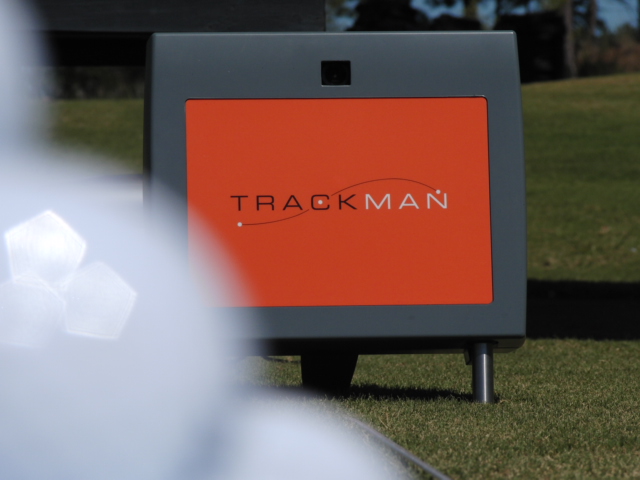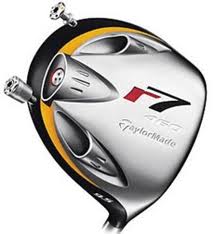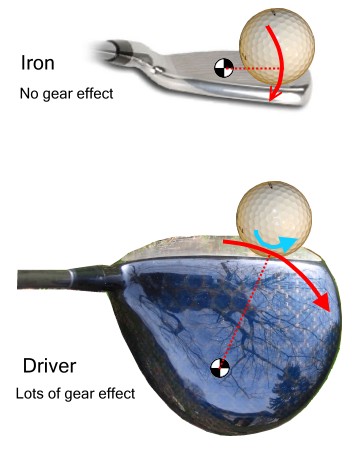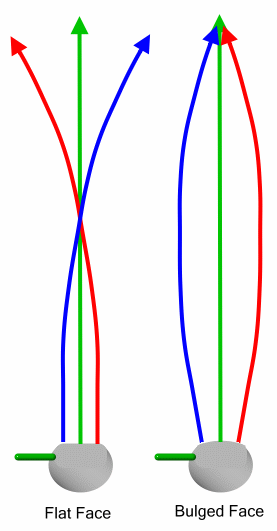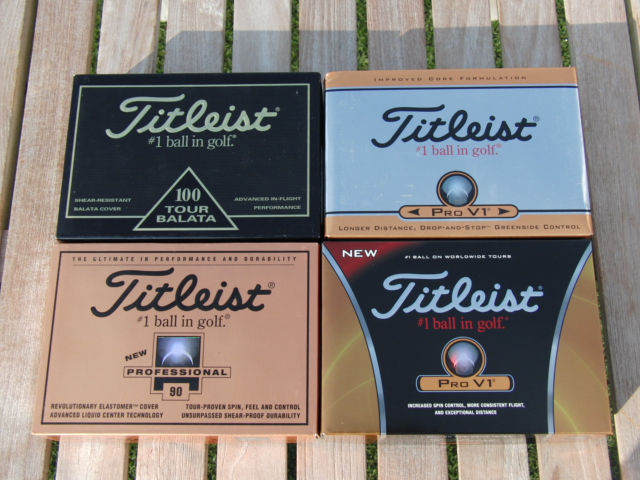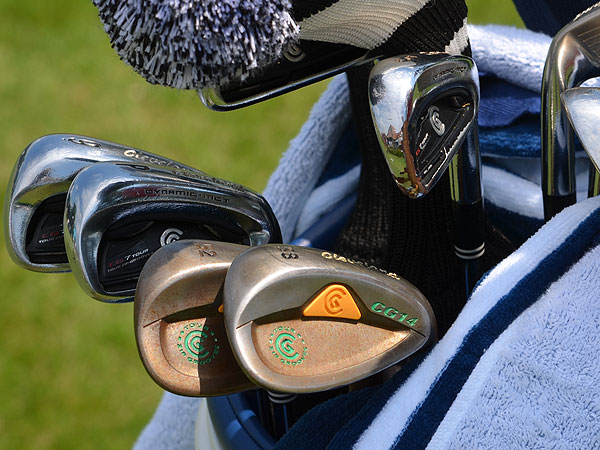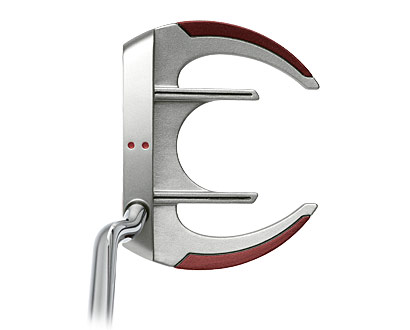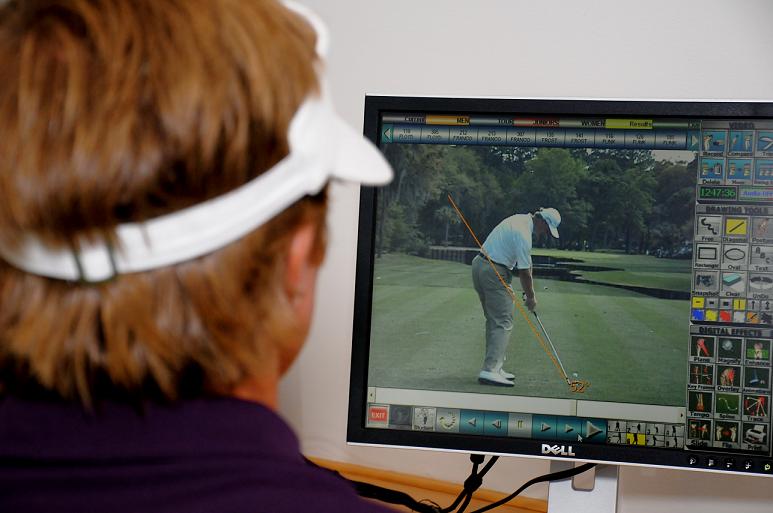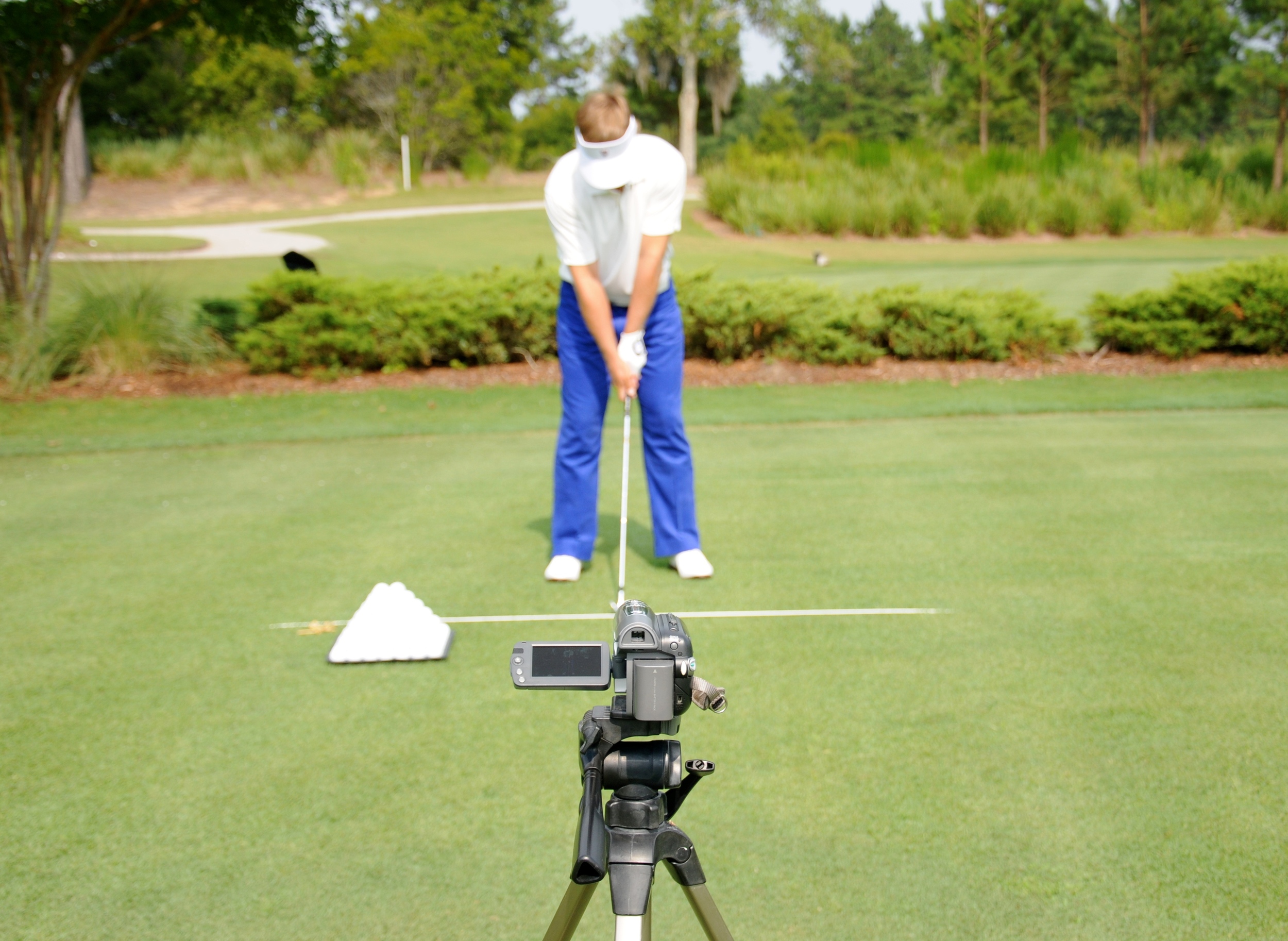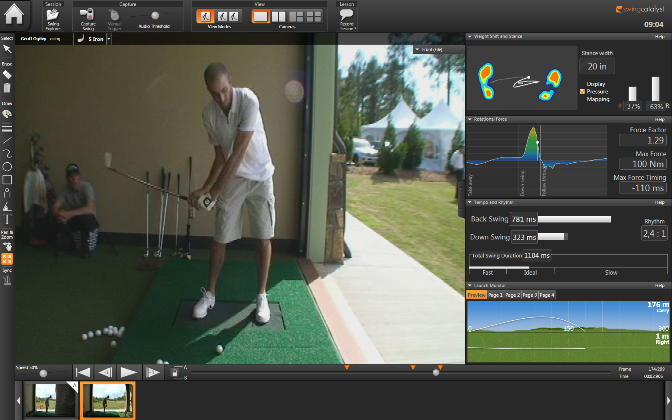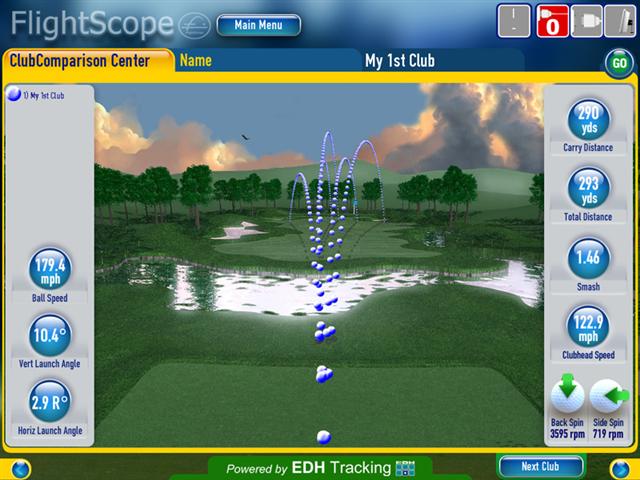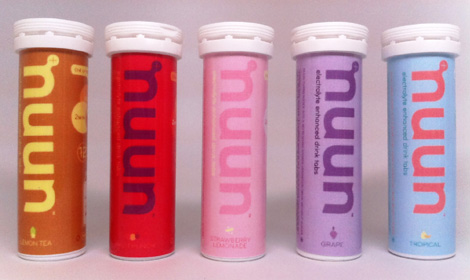The Driver and Accuracy (Part 2)
/
We all want to hit the ball straight and far of the tee don't we? In more technical terms our goals with the driver are to achieve the highest ball speed possible (distance), along with the desired flight pattern (accuracy). We want cake and we want to eat it too! Here's a run down on what club manufacturers have been working on to help us keep the ball in the fairway...
The primary factors directed towards accuracy are bulge and gear effect, center of gravity placement, adjustable heads or weights, a preset face angle and the clubhead design.
- The most interesting element built into each driver that serves to increase accuracy is the one two punch of bulge and horizontal gear effect. The face of every driver (all clubs requiring a headcover for that matter) has roll and bulge while irons do not. Bulge is the curvature of the face from its heel to its toe, while roll is the curvature of the face from the crown to the sole. Bulge starts the ball farther to the right on toe shots and farther to the left on heel shots and is a correction for the clubhead’s center of gravity (CoG) that causes hooking or slicing (gear effect) on off center shots. In other words, manufacturers have built bulge into the face to counter the negative results of gear effect. Here is an explanation (BTW Irons do display gear effect just far less than drivers):
Here's a definition of gear effect from Dave Tutelman (who has an excellent site for the scientist golfers out there):
Gear effect causes a ball to have sidespin which is the result of an off-center hit with a club whose center of gravity is well back from the clubface.
Without an off center hit and a CoG that is well behind the face gear effect cannot happen. In the picture above, we have a toe impact with an iron and a driver. The center of gravity (CoG) is indicated by the black and white circle. The collision between the clubface and the ball on the toe creates a torque that causes the club to twist - the club twists around the clubs' CoG which is indicated by the red arrow.
The CoG on the iron is virtually on the face and this type of strike causes the face to rotate open. This invariably causes the ball to fly weakly to the right as there is no gear effect on the spin imparted on the ball.
The driver is very different. With the CoG being further back from the face a toe impact causes the entire face to rotate around the CoG. As the ball compresses and grips on the face the red arrow causes the ball to actually rotate to the left (blue arrow) - the ball and the face actually work like two gears! Thus the term gear effect. And the reason why a toe hit with a driver tends to hook and a a heel hit tends to fade. Bulge helps out by launching a toe hit to the right of the target - a good thing if the ball has draw spin.
- The design and shape of the clubhead is something that we have seen much tinkering with in recent years. From the triangular Titleist 907 D1 (how could you forget that!) to the onslaught of ugly square heads - these designs all strive to do one thing - re-position the CoG to stabilize the head during off center hits. The longer (from face to back) the clubhead is, the further back the center of gravity is from the face which also increases gear effect. If you can deal with the aesthetics of these scientifically upgraded clubs by all means have at it.
- Another modern trend that has been proven to straighten wayward tee balls is the advent of adjustable weights or screws on the clubhead. Originally introduced by TaylorMade in their R7 line, tests have shown that the higher the swing speed the more a golfer is able to curve a ball by
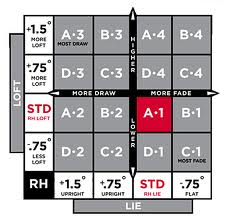 changing the weights in the clubhead. A golfer with a swing speed of 115mph (PGATour average is 112mph) will experience 35 yards of curve while a golfer with an average type speed of 85 mph will only experience 6 yards of corrective curve.
changing the weights in the clubhead. A golfer with a swing speed of 115mph (PGATour average is 112mph) will experience 35 yards of curve while a golfer with an average type speed of 85 mph will only experience 6 yards of corrective curve. - Along similar lines are the adjustable heads where the shaft rotates in order to adjust the loft or lie. While changing the loft will not do much to improve your accuracy, altering the lie angle can help you make subtle changes. Moving the shaft to a more upright position will promote a draw, while flattening will promote a fade.
- There is also the preset face angle. For those golfers out there who struggle with slicing this has been a tremendous help. If you feel like you could benefit from this just look for on offset driver or one that says draw somewhere on the head.
There are also rumors that there are certain shafts (Nunchuk) that make the ball go straighter, but I have not read anything or seen any convincing evidence to support this.
Thanks for reading and I hope that now you have a better understanding of what your driver can do for you....
The Driver and Distance (Part 1)
/
We all want to hit the ball straight and far of the tee don't we? In more technical terms our goals with the driver are to achieve the highest ball speed possible (distance), along with the desired flight pattern (accuracy). We want cake and we want to eat it too! There are numerous elements built into most drivers that often assist us in achieving these goals, yet so many of these small factors almost go unnoticed. Almost...
Factors in driver technology that influence distance are: length of club; shaft weight; head weight; loft; face material and thickness (CoR) and roll (vertical gear effect). Distance comes from our ability to convert clubhead speed into ball speed - often referred to as smash factor. Smash factor is an indicator of our efficiency at impact - are we getting out what we (our driver included!) are putting in?
- It seems to be fashionable these days for club companies to stretch the length of their drivers to 46 inches and claim that they are "superfast". The laws of physics indicate they are faster, but in my hands any speed gains are sacrificed with a loss of control. Ben Hogan used a driver that was 42.5 inches long and nowhere have I ever read that he was a short hitter. Personally I am not a fan of anything over 45 inches as this seems to be my threshold where distance decreases and control and centerdness of hit diminishes. I believe beginning golfers could use a 43 inch driver with far better results.
- Over the last decade shaft technology has come a long way and the most notable upgrade has been shaft weight. Miyazaki makes an incredible 39 Series driver shaft that can be as light as 44 grams - if you you cannot swing that faster then we have a problem. Barring feel and control issues I am a big fan of lightweight shaft technology and know it is something we should all take advantage of - even Keegan Bradley did.
- In pursuit of the "lighter is faster" formula a few companies have sought to reduce the weight of the clubhead. Cleveland Golf has their Ultralight line of drivers that are the lightest on the market today. A little known fact is that we could actually hit the ball further with a heavier clubhead (with speed being equal). By increasing the mass ratio of clubhead to ball you can increase ball speed, however the problem here is that as you increase weight you decrease speed, so once again there is a threshold to consider. The good news is the club companies have done all the research for us and most driver heads fall somewhere between 197 and 212 grams - something we can all manage.
- The loft of your driver is something that should be determined by an expert (someone who does this for a living!) fitter. A nice option with the new adjustable heads is that you can now alter the loft of your club without buying a whole new club. The more loft you introduce to the ball at impact the more spin and less ball speed you will create. The lower the loft, the more ball speed. One problem however - we would like to get the ball in the air and so, once again, there is a trade off. When it comes to loft, where possible, I encourage a golfer to go with less loft and show them how to overcome the reduction in launch angle by learning how to hit up on the ball. The golfer does most of the work here, but a reduction in loft can help with distance.
- The coefficient of restitution (CoR) is the spring like effect the face has when it collides with the golf ball. As you might expect the highest CoR on the face is in the center with lower numbers working out from the there. Golf's governing bodies have made it a rule that this spring like effect cannot be higher than 0.83 and as a result all club companies have made sure that their equipment is right up against the limit.
- The final, and perhaps most interesting, factor that increases the distance your driver makes the ball go is due to roll - no not roll on the ground, but roll on the face. Roll is the curvature of the face from top to bottom or crown to sole. Manufacturers include roll into the face design in order to create vertical gear effect on hits that are below or above center. A ball that is struck above center will actually spin less due to gear effect and as a result launch high with low spin - a winning formula for the long ball. Of course balls hit low on the face will spin more, but they more than likely need a little more air time. Please see Part 2 of this article for a full explanation of gear effect.
- I know of no face design or treatment that increases distance - unless you're working the Chapstick for more than just your lips!
The most efficient a golfer could be with the big stick would be to have a clubhead and shaft that fits them in every way, hit the ball from the inside with an ascending blow and strike the ball slightly above the center of the face and a touch towards the toe. The reason to favor the toe - the toe of a driver travels about 14% faster than the heel of the club!
I love this PGATour stat that measures how efficient each player on tour is with the driver. It quantifies a player's average distance divided by their average swing speed. It also shows each players average swing speed - an interesting read.
Check back soon to learn about what the driver can do for your accuracy....
Evolution of a Golf Ball
/I was recently handed a pristine collection of older model golf balls. It included a dozen Tour Balata 100's, a dozen Professional 90's and a dozen early model Pro V1's. There is no arguing that Titleist has held the upper hand in golf balls for almost 30 years and if you have played golf long enough you have no doubt had the pleasure of maneuvering one or all of these models around the course at some point. After a second of thought, the golf geek in me wanted to take them out for a test drive - see how far they go and what they might feel like. After all, it's been a long time since I had dented a Tour Balata.
Thankfully, wisdom prevailed and I decided to get some real numbers on the balls with the help of TrackMan. I realized that, including the most recent model of the Pro V1, I had access to four generations of Titleist golf balls. I had balls from the '80's, '90's, 2000's and today and I wanted to experience first hand what the differences might be.
I needed a very consistent driver of the golf ball and the best man at hand was Zack Brady from Atlantic Golf Club. Zack is an exceptional golf professional who can really play. He also happens to be one of the better drivers I've seen. I sacrificed six balls from each generation and had him hit them on a rotating basis going Balata, Professional, Pro V1 and new Pro V1. I did this to negate the effect of any changes in swing or weather. Zack hit twenty four shots on the Trackman and the average from the six shots with each model was calculated. Here are the results with each set of balls:
Tour Balata 100
- Total Distance 261.6 yds
- Carry 224.7 yds
- Clubhead Speed 110.1 mph
- Ball Speed 160.7 mph
- Smash Factor 1.46
- Attack Angle -0.4 degrees
- Spin Loft 9.0 degrees
- Launch Angle 6.5 degrees
- Spin 2789 rpm
Professional 90
- Total Distance 262.1 yds
- Carry 231.9 yds
- Clubhead Speed 110.6 mph
- Ball Speed 161.4 mph
- Smash Factor 1.45
- Attack Angle -1.1 degrees
- Spin Loft 6.9 degrees
- Launch Angle 6.5 degrees
- Spin 2915 rpm
Pro V1 - 392
- Total Distance 286.4 yds
- Carry 251.9 yds
- Clubhead Speed 110.1 mph
- Ball Speed 164.7 mph
- Smash Factor 1.50
- Attack Angle -3.0 degrees
- Spin Loft 10.8 degrees
- Launch Angle 6.5 degrees
- Spin 2739 rpm
Pro V1 New
- Total Distance 298.4 yds
- Carry 271.1 yds
- Clubhead Speed 110.8 mph
- Ball Speed 167.2 mph
- Smash Factor 1.51
- Attack Angle -3.1 degrees
- Spin Loft 11.7 degrees
- Launch Angle 7 degrees
- Spin 2850 rpm
Things you should be aware of: The numbers listed above are an average of the six shots struck with each ball. Each ball was only hit once. The golf balls, while all pristine and "new" are very different age wise. The balata balls have been waiting in their sleeve for more than twenty years for someone to play with. The balls had all been stored in an air-conditioned space and were stored together. The weather was a crisp 74 degrees with a slight left to right breeze blowing - lovely for August! Zack used a Titleist D3 9.5 driver with a Diamana 'ahina X shaft by Titleist.
Points of Interest:
- Obviously the distance gaps were what interested me most and there were no real surprises there, other than the "upgrade" from the early Pro V1 to the newer model - almost a 5% increase!
- The huge leap in distance off the tee on the PGATour in 2000 is due to only one thing - the introduction of the Pro V1. An increase in distance of almost 10% over the scuff resistant Professional.
- I thought the spin rate on the wound balls (Balata and Professional) would be through the roof. Not so! The balls sounded very soft off the face and seemed to struggle to get into the air - almost as if they were unhappy to be put into play this late in the game! Zack said it felt like he was hitting ping pong balls.
- I was very interested in the fact that the smash factor was lower with the two softer balls. It almost seemed as if it was more difficult to get the smash factor up due to the softness/compression of the ball. BTW, smash factor (generally speaking) is the ball speed divided by the clubhead speed and it measures the efficiency/quality of the strike.
- The older/softer balls definitely curved more than the more modern models. This was noticeable even to the untrained eye.
- Since the study I have gone back and weighed each model of golf ball measured. I have long been under the impression that all golf balls weighed 46 grams. The Tour Balata (43gr) and the Professional (42gr) were much lighter than the others (46gr). Not sure if a ball can "lose weight" or were they made at that weight?
On a side note: I also had Zack hit six older model Pro V1X - 332 balls. I kept this data out of the study as I wanted to key in on four separate generations of Titleist balls and this model was a relative of the early model Pro V1 we studied. Interestingly enough this was the ball that traveled the furthest - a whopping 307.3 yds! (All the additional clubhead numbers were similar to the other models). I took from this that it is important to play a golf ball that fits your clubhead speed/game. With a driver speed in the vicinity of PGATour average (112mph), Zack currently plays the new Pro V1X and this study confirmed that the X is the right ball for him.
The moral of the story is that when it comes to golf balls, new technology fitted to the appropriate golfer makes a real difference. Take the time to chat with a teacher or professional you respect and get some sound advice as to which ball might make a difference for you. Oh, and that pristine logo-ed dozen you've been saving for that special course, remember the one your buddy bought back from Augusta for you in '78 - eh...not so good.
Keegan's Winning Bag
/Here is Keegan Bradley's equipment:
Driver - Cleveland UltraLite TL310 10.5° driver with a Miyazaki Kusala 61 shaft. The Miyazaki shafts have been a great hit with new technology that has allowed the shaft to become lighter yet maintain the stiffer flex required by tour professionals.
Fairway - Cleveland FL 14° fairway wood with a Miyazaki Kusala 83 shaft. The golf club is 30-grams lighter than most other fairway woods and therefore offers more clubhead speed.
Hybrids - Cleveland Launcher DST 18° with a Project X XHB6 shaft and a Cleveland Mashie TM3 20.5° with a Miyazaki C Kua 105 shaft.
Irons - Cleveland CG7 Tour irons (4-PW) with X-100 True Temper Dynamic Gold Tour Issue shafts. The tour issue shafts are slightly heavier and stiffer than regular issue.
Wedges - Cleveland CG14 with lofts of 52° and 58°, fitted with S-400 True Temper Dynamic Gold Tour Issue shafts. The CG14’s are in fact older wedges that have been brought back into the market - I like his personalized "Irish" addition to them.
Putter - Odyssey White Hot XG Sabretooth mid-length putter. Bradley is the first golfer to win a major with a long (belly or chest) putter.
Ball - Srixon Z-Star. Interestingly, four different ball brands won Majors in 2011.
Clubs Too Upright, Too Light?
/Thanks to reader Chuck for this enlightening article posted by Bradley Hughes from www.bradleyhughesgolf.com:
FLAT LIE ANGLES - The Reason and Logic Of The Greats
I know from personal experience in a question asked directly to Lee Trevino that he used clubs that were at least 3 degrees flat in lie angle from the old standard. Doug Sanders also informed me in the interview I recently did with him (on page 2) that he had his clubs flattened down so the toe sat down and the heel would never strike the ground first. If we look at Ben Hogan's club that is in USGA Golf House Museum it is close to 6 or 7 degrees flat in lie angle when compared to clubs of the same length and loft of today.
 If flat lie angles were the choice of the game's best ball strikers throughout history then WHY do manufacturers insist on putting upright lie angled clubs in the hands of golfer's today?
If flat lie angles were the choice of the game's best ball strikers throughout history then WHY do manufacturers insist on putting upright lie angled clubs in the hands of golfer's today?
- The upright clubs make the player come steeply into the ball on descent.
- The upright clubs tell the body stall and insist that the hands flip through impact to try and square that upright lie angled club with the ground.
- The upright club straightens the right arm away from the body and increases clubface roll throughout the shot making timing a huge problem.
- Upright lie angles deteriorate the swing by not stressing the importance of swinging the golf club behind and around the body and rotating through impact with the correct body effort and sequence.
Too often we now see golfers throwing the club through impact - pushing the club head off to the right of the target or throwing the clubhead left of the target with their hand roll - flipping the club face over by hand action trying to correct the mistake. Today's clubs should all come with a warning label: "Swing Deterioration And Poor Mechanics Possible By Using This Club"
Add the fact that the shafts are too long and the swingweights and overall club weights are too light and it is little wonder we don't see ball striking mastery on any level any longer. Remember: Feedback of the club and the swing is necessary for improvement to take place. That's why golfers are not improving. They don't know the difference between a good strike or a bad strike of the ball because the permieter weighting and large sweet spots don't allow such reference. The equipment golfers are using is NOT designed to help them adjust their swing to the correct efficient motion.
Bradley Hughes
Very well said Mr. Hughes. I have an inkling as to why manufactureres insist on making clubs lighter and more upright...... Firstly, the clubs are more upright as it causes the faders, who happen to be the majority of golfers, to reduce the amount of curvature of their shots. Notice I never said anything about improving their swings - the upright lies in fact encourage these golfers to continue swinging the way they always have. And secondly, the light weight leads to more speed which creates a Wow! factor when they first hit the clubs. The lighter the club the faster you can swing it. You also, however, relinquish a measure of control over the clubhead and a feel for the club.
So the slicer who tries his buddies new 7-iron and hits a straight bomb over the green is amazed as he has never hit the ball that straight and that far before - he simply must have a set!
As with most things it comes down to $$$$! Don't get sucked in and allow yourself to be enticed with new gimmicks. Know your numbers (length and lie) and play something you like the look of and can feel.
Ever Considered an Online Lesson?
/With technology being what it is today it is very easy to stay in touch with a golf instructor that might be half way around the world. Most smartphones incorporate a video recording feature and some of the better footage of golf swings I have received have been emailed to me straight from a students' smartphone.
There are four simple steps required to have an online golf lesson with Andrew. Here's how:
1. Create a Video of Your Swing
2. Upload the Video for Sharing/Viewing
3. Pay for your Lesson via PayPal
4. Email me the Link to your Video for Analysis
Once all four steps are completed Andrew will let you know when your video has been evaluated. If you choose to have a phone consultation along with a video lesson Andrew will coordinate with you once the video lesson has been analyzed.
Online Lesson Pricing
Video analysis only – $50 Video analysis with 15 minute phone consultation – $80
Follow these steps to get the ball rolling:
- Create A Video of Your Swing
Capture one swing from face on and another swing from down the line. Take care when recording your swing to ensure the best results for your online lesson. Use a tripod, or a friend with a very steady hand as a moving camera leads to moving reference lines in the analysis. Camera positioning is also important. The face on shot should be at 90 degrees to the target line and the down the line shot should place the ball between the target and the camera lens ie. shoot straight over the ball toward the target.
- Upload Your Swing Video for Viewing
We have two ways you can upload videos to us, YouTube and V1 Software. Don't be intimidated, dive in - it's far easier than you might imagine!Here are instructions for both methods:
A good way to publish your swing video for an online lesson is to upload it to YouTube. During the upload process, you can select Public or Private for your video. Selecting Private will restrict viewing only to those that have the link.
You will need a YouTube account, so if you don’t already have one you will need to create one, which is a simple process and free of charge.
Here are the instructions from YouTube on uploading video. As you might imagine, there is also an instructional video on uploading to YouTube.
Once you have uploaded the video, check that it has been successful by clicking the link provided and watching the video.
For use and upload with a PC you will need V1 Home 2.0 which is available free of charge HERE. Upload directions are included with your free download.
For use and upload with an iPhone, iPad, iTouch or Android phones purchase the app HERE. V1 Golf actually has the #1 sports analysis app in the world at the moment.
- Payment via Paypal
We only take payment via PayPal. If you do not have a PayPal account go to www.PayPal.com and set one up. It is very easy and makes online payment for anything so much easier. Payment should be made to andrew (at) andrewricegolf.com
- Contact Us with Your Lesson Request
Once your swing is uploaded uploaded, send us the link to the video along with your request for an online lesson and we'll get cracking.
Please also be sure to indicate your selection of video analysis or video analysis with phone consultation. Current turnaround for online lessons is 48-72 hours.
Should you have any questions about receiving an online lesson please shoot me a note to andrew (at) andrewricegolf.com and I'd be happy to to help.
2011 Orlando PGA Golf Show
/ I have recently returned from the 2011 Orlando PGA Golf Show and I wanted to share a few of my impressions with you. Firstly, if you are an avid golfer, you simply must make a plan to attend this show - it is literally the Disney World of golf! Talk to your golf professional, a friend in the biz, beg, steal, but find a way to get there. Plan on two full days (preferably Thursday and Friday) to soak it all up.
I have recently returned from the 2011 Orlando PGA Golf Show and I wanted to share a few of my impressions with you. Firstly, if you are an avid golfer, you simply must make a plan to attend this show - it is literally the Disney World of golf! Talk to your golf professional, a friend in the biz, beg, steal, but find a way to get there. Plan on two full days (preferably Thursday and Friday) to soak it all up.
This year there seemed to be a positive vibe at the Show. All the major club companies were represented with Taylormade commanding a huge portion of the floor. My four high points of the Show were:
Once again I have nominated this product as one of my highlights. It might be costly, but this machine dispenses invaluable information for any golf coach. It shows where a golfers weight is positioned throughout the swing, how much rotational force is being generated, all while synchronizing with video and either Trackman or Flightscope. Talk about an all in one package! This is the G5 of golf instruction technology.
The new and improved Flightscope X2 portable launch monitors do not offer anything groundbreaking relative to what Trackman has always offered, but where they crush the competition is price point - $11,000 vs $30,000+! The accuracy of the Flightscope has always been brought into question, however after meeting with them and seeing the new X2 in action I am sold. Not new technology, but definitely a new price point at which to consider the technology.
Nuun tablets are optimal hydration and I believe the future of hydration in sports. The taste is light and refreshing and I really like the "green" aspect of this product - you carry your own Nuun waterbottle, fill it with water and add a tablet without loading up the landfills with plastic bottles from everything you drink on the golf course. The speed of absorbtion, electrolyte content and lack of carbohydrates (sugar!) is what sets this product apart. It tastes really good too.
In an almost unnoticed about face by Momentus (which has always promoted heavy clubs) they are now promoting the Speed Woosh to increase your clubhead speed. Well what about all those heavy clubs I bought that are lying in my garage? Sorry, no good - at least if you want more speed! This device is great fun to swing and as an added bonus it works. It gets the fast twitch muscle fibers to fire and that can only help you add distance to your tee balls. I like it!
In additon to these four highlights I saw a little bit of everything - from six different types of golf tee designs to a device to keep your head still in the swing (it actually worked!) There were also the usual cast of golf celebs from Greg Norman to Hank Haney (hi Hank!) to Natalie and Paula. I also attended a few excellent seminars by AMF and noted golf instructor Jeff Ritter. Jeff gave an inspirational talk on marketing golf instruction in the modern society.
After leaving the show I felt excited and enthusiastic about the future of our game. We seem to be turning the corner and I am really looking forward to 2011.
Thanks for reading and feel free to post your questions and comments.
Golf Instruction News
/The Berkeley Hall Learning Center has just been completely upgraded! We have just had all our computers upgraded with the latest software from V1 Golf. Students will now be able to view a summary from their golf lesson online in their own V1 locker or on their smartphone. Students will even have the ability to upload their lessons onto Facebook for all their friends and family to see. The changes at the Learning Center include an expansion of our indoor putting capabilities, two Casio EX-F1 Exlim 300 frame per second cameras (for amazing high speed footage of a golf swing!) and the ability to view your golf swing on a 50" HD screen. Casio EX-F1 Exlim Camera
Read MoreThe Facts About Putters
/60% of all the grass on putting greens today did not exist 30 years ago and as a result the mow height on greens is 50% lower than it was 20 years ago. Greens are much faster than they used to be.Faster green means shorter grass and shorter grass means there is no longer the need for 4 degrees of loft (the traditional loft) on putters. Most PGA Tour golfers have an effective loft of somewhere between 1 and 3 degrees. This means that when they add the loft on the putter face to the amount of loft they add during the stroke it comes out to somewhere between 1 and 3 degrees. Consequently very little flight time and early roll mean less bounce and skid - a good thing! Zach Johnson actually has -1 degree of loft on his putter face. Speaking of early roll - grooved face putters get the ball rolling 18-24% sooner than smooth faced putters. Not only that, they deter the ball from sliding up or across the face on poorly struck putts too. Sign me up for some of that help.
Read MoreThe New Driver Terminology...MoI, CoR and CoG
/As players on the PGA Tour started using 20 year old Ping Eye2 Wedges I started thinking about how much (or little) technology has effected equipment in the last two decades. The facts are: Other than changes in the golfball, driver and the invention of hybrids very, very little has changed. Excluding the advent of perimeter weighting (which is very similar to toe/heel weighting) when it comes to irons there have been no groundbreaking upgrades. Wedges are the same and fairway woods are just like they used to be - in fact, the better ones look just like the really old ones. The driver has been the primary club in the bag for technological advancement. And with this progress has come an entirely new language. What does MoI mean? What is Cor? Whaaat....? Here is a brief primer, compliments of my friend Ian Hayes, on some new driver terminology:
Read MoreA Highlight from the 2010 PGA Show in Orlando
/I have just returned from the PGA Golf Show and came back with a very positive vibe. While it is always good to catch up with friends, old and new I feel that the game of golf is doing just fine even without Tiger. Here are a few notes on what I found to be the highlight of my trip:
Even though this is their second year at the show I found Swing Catalyst Studio to be the most exciting and positive piece of technology involving golf instruction. Last year I reported on the Swingia Balance Plate, but the Swing Catalyst takes the same idea to a new level.
The Swing Catalyst Force Plate seamlessly integrates with video analysis software and an optional launch monitor (TrackMan). The force plate is housed in a tee unit covered with artificial turf.
The Swing Catalyst Force Plate enables the teacher to view a student’s centre of gravity, stance and pressure distribution both live and recorded, in real time and in slow motion. Additional data on rotational force, tempo and rhythm are also available once the swing has been captured.
The best feature shows what percentage of a golfers' weight is on each foot. Many systems have this option, but none go so far as to indicate what part of the foot the weight is located on.
When integrated with a TrackMan system and 300 fps cameras, Swing Catalyst provides the optimal in instructional tools - an upper level viewing experience, all the numbers pertaining to the club and ball flight and now all the numbers pertaining to the body, force and weight positioning.
With integration this really is the Rolls Royce system available on the market today.
Read MoreUsing Wedge Bounce Correctly
/For example: A club with ten degrees bounce will have a ten degree angle between the sole and the ground (barring any rounding of the sole). Notice how the back edge of the sole of the wedge rests on my finger, while the leading edge is slightly raised. Thanks to Gene Sarazen, who first invented bounce, irons have been built this way to deter the leading edge from shoveling or digging into the ground.
Read MoreEquipment Factoids
/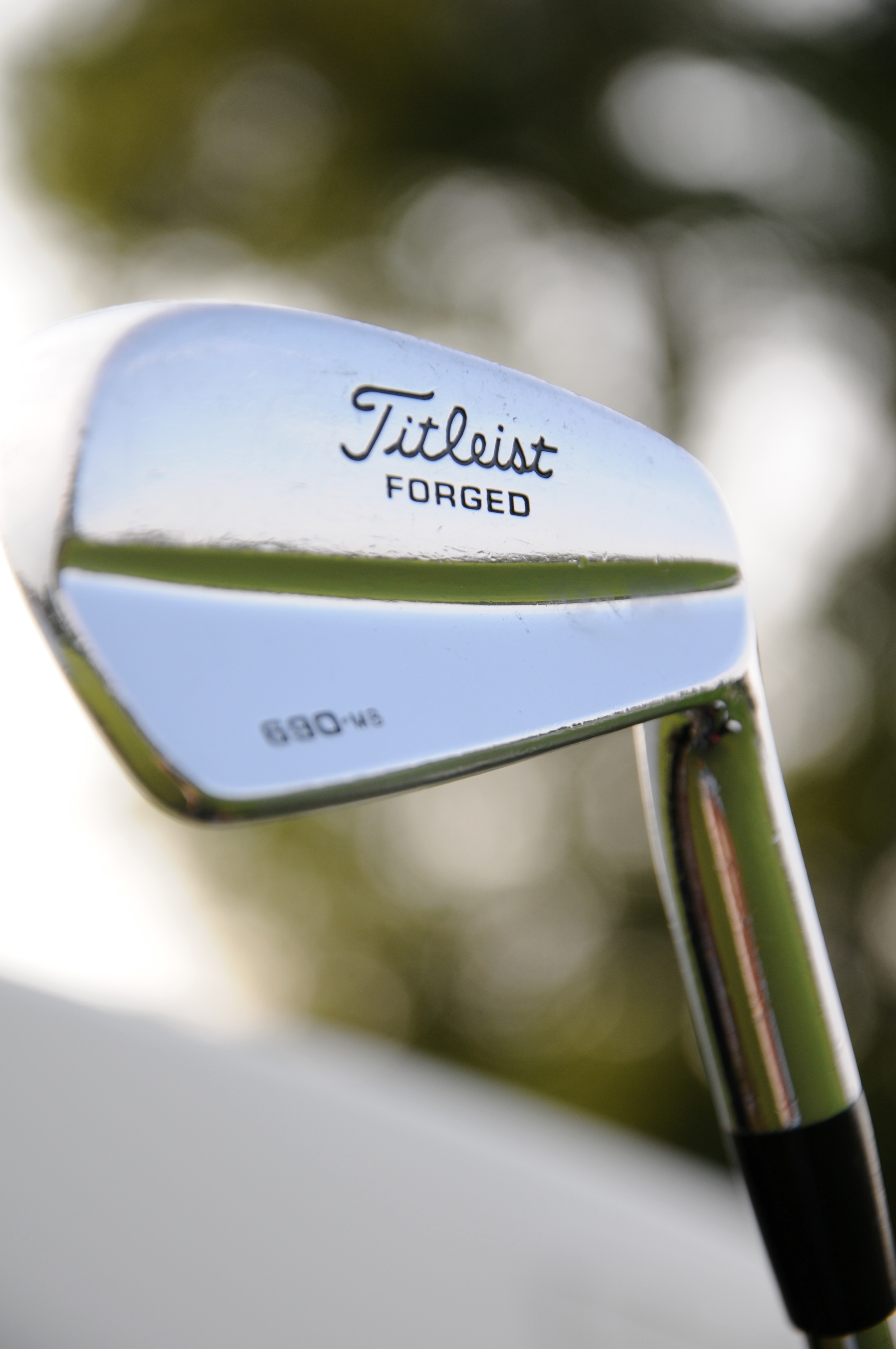 So often golfers are tempted into believing their equipment is the reason for the poor results they have been experiencing. Sometimes they may be correct, yet most times, this leads to the decision to make a change.
So often golfers are tempted into believing their equipment is the reason for the poor results they have been experiencing. Sometimes they may be correct, yet most times, this leads to the decision to make a change.
Here are a few simple things to keep in mind when considering making a change to your set:
- The latest and greatest is not necessarily all it is hyped to be. It is more than likely the same old thing with a new and exciting paint job. Decide what you like and stick with that! I am currently using a set of irons with the same type of heads (blades), shafts (Dynamic Gold s-400) and grips (rubber with reminders) that I used when I first started to play the game. (Titleist 690.MB)
- When it comes to irons there are three options: blades; the oversized helper set; and something in between the two. Get something you know you will be comfortable with.
- As far as fitting for irons we all need to know two numbers: the length and lie angle that we prefer! Not 2 degrees over standard or plus a half inch on length! This is because all companies have different standards (don't we all?) and if you know the length and lie of your clubs you are immune to any problems that might arise. My 6 iron is 37.50 inches long and has a lie angle of 60.50 degrees. I will use those numbers for as long as I can swing.
- Get clubs that fit your body and not strictly your impact position on the day of fitting! Lose the lie boards and tape on the bottom of irons please.
- Find a shaft that fits your swing and feels good to you and then stay with it for as long as they make it! Make sure it is not too strong.
- When it comes to putters keep in mind that there are essentially two genres: face-balanced and toe weighted. If you are considering making a putter change try to stay in your genre unless things have just been horrific on the greens.
- There have been very few to no improvements made in the field of fairway woods. Titanium is very light and thus the heads tends get too big, so find a simple and small stainless steel head that you like the look of and set about developing a long lasting relationship with it.
- When selecting a fairway wood decide whether you would like to use it predominantly off the fairway or more as a tee club. Select the loft of the club accordingly.
- Limit the number of wedges in your bag to a maximum of three - that means a PW, SW and an LW at most! If you struggle with the wedges stick to a PW and SW so as to not cloud any decision-making around the greens. Tour players practice enough, are skilled enough and play the kind of courses that require precise enough shots to justify four wedges being in the bag.
- There should be an even number of degrees between each of your wedges. Most PW's are 48 degrees and I have a 54 and a 60. Other viable options are a PW and a 52 and 56 or a PW and a 53 and 58.
- When selecting your wedges be sure to incorporate enough bounce in each club. Unless your name is Eldrick, Phil or Vijay you need more than 6 degrees of bounce on any wedge you own. That's why manufacterers build clubs with 14 degrees of bounce!
- There are two shapes of grips folks - rounds and reminders! Find out what shape you like and ask for it by name the next time you refresh your grips.
- When it comes to grips forget the latest cool colors or which ones your favorite player is using - they are more than likely getting paid to use the ones on their clubs. Decide which grips are for you and your preference and now you don't have to worry about the latest fad.
- The driver is the one club in the bag where it pays to stay current. Find a reputable club fitter in your area that uses a launch monitor and go and get fitted. Whenever you get the urge to replace your current big stick get back on that launch monitor to compare the latest offering with your trusty old steed!
- The current fitting carts that most companies have make it very easy to try multiple different heads with various shafts. Be patient, try them all and then find a club that gives you good numbers and looks great to you!

Enjoy watching the world's best wade through the quagmire that appears to be the 2009 US open this weekend.....



